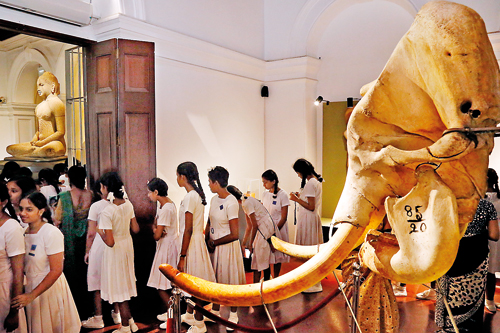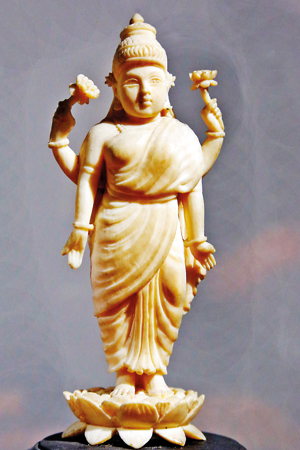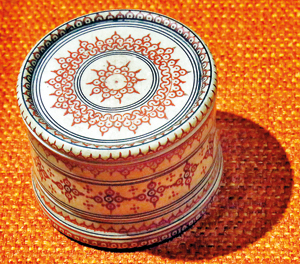Rare ivory and pearl exhibition with a message

Schoolchildren visiting the exhibition. Pix by M.A. Pushpa Kumara
To mark International Museum Day on May 18 (declared by the International Community of Museums -ICOM), the Colombo National Museum has on display a temporary exhibition of ivory, pearls and exotic sea shells.
This exhibition which is on until June 18 highlights the dexterity of the Lankan craftsmen of yesteryear – seen in intricately crafted jewellery boxes, figurines, replicas of stupas and handloom shuttles on display.
“Although ivory was a rich form of art in ancient Sri Lanka, it should be remembered that ivory was sourced for the art from dead tuskers. The traditional Lankan artisan did not warrant the poaching of wild elephants for this purpose, although the practice was introduced by the colonial rulers and tragically continued to date,” says the Assistant Director of Zoology, Department of National Museum, Lankani Somarathna.
The exhibition also draws increased public attention to the problem of elephants being killed for their tusks. “Tuskers are killed in large numbers today in search of elephant pearls and their tusks but little do these poachers know that only a handful of them actually have this and many die in vain,” says Ms. Somarathna.

Goddess Lakshmi
The exhibition features a collection of selected exhibits which are not among Colombo Museum’s permanent exhibition collection, including a delicately designed statue of God Vishnu and Goddess Lakshmi, replicas of stupas dating back to the 17th century and an elaborately designed handloom shuttle. There is also a rare collection of sea shells, including a collection donated by the celebrated diver, late Rodney Jonklaas. All these are from the Zoology Division of the Museum. Apart from the permanent exhibits which the public gets to see, the Museum is also a repository to an extensive collection, some of which is showcased from time to time through temporary exhibitions.
Several pairs of tusks confiscated through court proceedings of the early 19th century and deposited at the Museum are also on display. This, Ms. Somarathna reiterates, is not for their ornamental value, but to drive home the point that, they are of no beauty when separated from the animal.
Director, Department of National Museums, Sanuja Kasthuriarachchi said that it was after several years that a temporary exhibition of this nature comes to the public. “It offers a fresh experience of viewing exhibits which are not in the permanent exhibition galleries of the museum.” Ventures of this nature encourage more people to visit museums, she adds.
A museum, although dedicated to antiquity, cannot exist in isolation, points out the Deputy Director-Ethnology, Department of National Museums, Senerath Wickramasinghe. “It should be essentially public-centric,” he feels. As a country claiming an ‘object-rich’ heritage, a more solidified effort to ‘market’ it should be in place. “Not many nations can fuse nature tourism with cultural tourism, and we need to capitalize on this strength,” he says pointing out that ‘museum marketing’ is an integral part of modern cultural tourism.
| IVORY CARVING AS AN ART | |
 An intricately designed jewellery box Ananda Coomaraswamy, in his work Medieval Sinhalese Art, writes: ‘The ivory carver is usually an all round craftsman of the highest rank, a galladda used to practice both painting and building also.’ The ivory carver’s chief tools are his saws and gravers and chisels and his work, as the author observes, ‘is varied in character, covering a wide range of objects required for religious, architectural and personal use.’ P.H.D.H De Silva and Senerath Wickramasinghe in their work, ‘Ancient and Traditional Boxes, Caskets and Chests in Sri Lankan Museums, 8th to 18th Century (Volume 1) note: ‘it is believed that similar to carpentry workshops established in the low country of the island, workshops producing ivory boxes, caskets and cabinets employing high skilled Sinhalese ivory carvers were established by the Portuguese in Colombo and also probably in Galle.’ The authors, citing numerous sources also note that works of ivory have been made by local artisans on commission for the Portuguese traders for the European market. Some have been especially made to be gifted to visiting delegates during colonial times. Some of these items are today among the exhibits of world renowned museums including the British Museum and those in Lisbon, Vienna and Zurich. |


